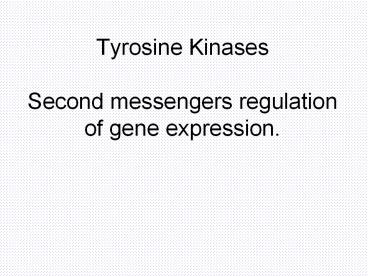Tyrosine Kinases Second messengers regulation of gene expression' - PowerPoint PPT Presentation
1 / 30
Title:
Tyrosine Kinases Second messengers regulation of gene expression'
Description:
Four classes of growth factors are present in mammals. ... kinase binds the beta 2-adrenergic receptor via phospho-Tyr-350, phosphorylates ... – PowerPoint PPT presentation
Number of Views:54
Avg rating:3.0/5.0
Title: Tyrosine Kinases Second messengers regulation of gene expression'
1
Tyrosine KinasesSecond messengers regulationof
gene expression.
2
Four classes of growth factors are present in
mammals. They dimerize and activate after the
growth factor binds. Activation consists in
self-phosphorylation bringing about tyrosine
kinase activity
3
Neurotrophin and NT receptor dimerization upon
binding
Nature Reviews Neuroscience 4, 299 -309 (2003
Moses Chao
4
Mechanism of action of a receptor tyrosine
kinase 1 dimerization 2 self-phosphorylation 3
non-self phosphorylation
5
Different pathways associated with Trk and p75
neurotrophin receptors
6
Besides their trophic effects, Trk receptors
also activate acutely membrane channels
7
Trk receptors can be activated also by stimuli
different from neurotrophins like some specific
G-protein activation (adenosine receptors or
PACAP receptors).
8
Secretase, enzymes involved in Alzheimer disease,
cleave p75 in two separate points. The
intracellular fragment is a possible nuclear
signal for cell degeneration.
9
- Cellular effects of the activation of
neurotrophins
10
Trk A inhibition do not affect cortical
developemnt but Trk B and Trk C inhibition
does While NGF is only expressed in a limited
set of neurons in the brain (including the
cholinergic neurons of the basal forebrain), BDNF
and NT3 are expressed in the brain. In
particular, they have complementary exrpessions
in thalamorecipient and non-thalamorecipient
layers.
11
Injection of BDNF or NT-4/5 disrupts the pattern
of ocular dominance columns in the primary visual
areas, suggesting their role in the
thalamocortical axon segrgation.
12
Green BDNF, red dominance columns The figure
illustrates that where BDNF is overexpressed
dominance columns are scrambled
13
BDNF induces acute presynaptic effects on
miniature EPSC
14
Non-receptor tyrosine kinases src, PLC?1, GAP,
Grb, yes, fyn
15
- Target of tyrosine phoshorylation are a series
of ligand gated ionotropic channels - - Nicotinic receptor
- - NMDA receptor
- - GABA receptor
16
Tyr phosph also affect desensitization of
metabotropic receptors c-Src tyrosine kinase
binds the beta 2-adrenergic receptor via
phospho-Tyr-350, phosphorylates G-protein-linked
receptor kinase 2, and mediates agonist-induced
receptor desensitization
17
- Modulators that activate genes
18
(No Transcript)
19
- Role of CREB Binding Protein
- when CREB Ser133 is phosphorylated, CBP binds to
CREB, through its Kinase Inducible Domain and Q2
regions, and stabilizes the transcriptional
complex CREB DNA polimerase
20
(No Transcript)
21
- Some of the genes activated by CREB can directly
express proteins. - On the contrary, others can be other
transcription factors starting the transcription
of another gene down hill
22
(No Transcript)
23
MEK activation induces physical modification in
the synapses
24
Gene activation is associated with Functional
long-term synaptic modifications
25
control
MEK inhibitor
26
hormones
- Derived from cholesterol (above)
- Produced by the surrenal gland
- Highly lipophylic
27
Stress hormones Sex hormones
28
hormones influence neural activity and morphology
BDNF reactivity Sham Progesterone
29
Stress hormones activate gene enhancers
(promotor activators)
Transcription factors and other proteins that
bind to regulatory sites on DNA can be regarded
as passwords that cooperatively open multiple
locks, giving RNA polymerase access to specific
genes
30
Hormone receptors share common sequences
The role of the hormone binding domain in an
intact receptor is to prevent DNA-binding domain
from interacting with DNA unless the hormone is
bound
















![[VII]. Regulation of Gene Expression Via Signal Transduction PowerPoint PPT Presentation](https://s3.amazonaws.com/images.powershow.com/4917995.th0.jpg?_=20131220041)














